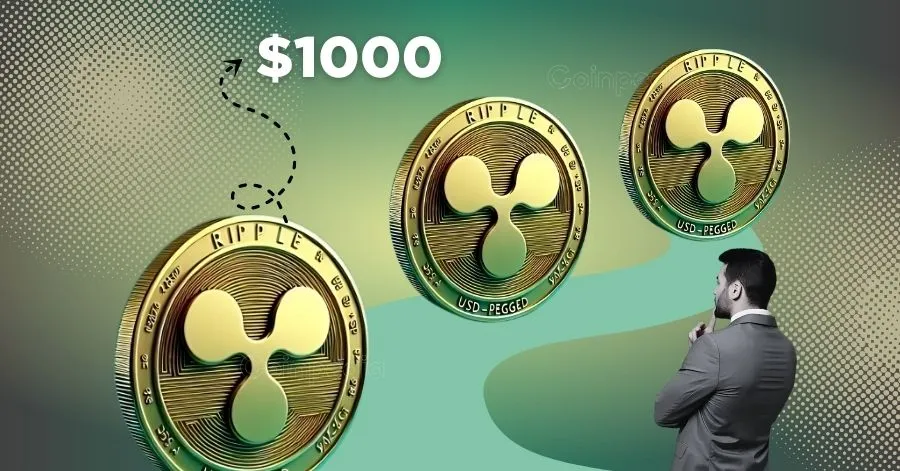The question of whether XRP (Ripple’s native cryptocurrency) could reach a $1,000 price point or turn modest investments into millionaire-level wealth has sparked widespread debate in crypto communities, financial news outlets, and among market analysts. This analysis delves into various perspectives, market dynamics, mathematical realities, and contextual factors drawn from the latest discussions and data around XRP’s price potential and investment returns.
XRP’s Market Cap and Realistic Price Ceiling
One of the most critical factors in determining whether XRP could hit $1,000 lies in the mathematics of supply and market capitalization. XRP currently has approximately 57.1 billion tokens in circulation. At $1,000 per token, XRP’s market capitalization would balloon to $57 trillion. This figure is vastly larger than the entire global cryptocurrency market combined or even the GDP of the largest economies.
For comparison:
– Bitcoin, the largest cryptocurrency by market cap, has hovered around a few trillion dollars at its market peaks.
– Traditional global financial giants and sectors provide benchmarks: the combined market capitalization of the 10 largest banks is roughly $3 trillion.
– The total payments sector worldwide, which Ripple aims to impact, is worth around $2.7 quadrillion in volume but not directly comparable to market cap.
Therefore, many experts and analysts, including market watchers on TradingView and Reddit, consider a $1,000 XRP price highly unrealistic given these macroeconomic and market constraints. The market cap that would accompany such a price surpasses current financial ecosystem scales by an order of magnitude.
Ripple’s Legal Context and Market Implications
The prolonged SEC lawsuit against Ripple Labs has been a significant source of uncertainty and price suppression for XRP. In March 2025, CEO Brad Garlinghouse announced the SEC’s lawsuit had been dropped, which positively shifted market sentiment.
Historically, XRP’s legal battles have hindered broader adoption and institutional investment. With regulatory clarity now more in favor of Ripple, some optimism arises about XRP’s market growth potential.
Yet, while this resolution could stimulate higher prices and use cases, it alone doesn’t offset the mathematical improbability of extreme price increases such as $1,000 per token unless accompanied by extraordinary demand and massive supply reduction.
Investment Returns and Millionaire-Maker Claims
Cryptocurrency media outlets and analysts frequently explore whether XRP can transform modest investments into millionaire fortunes:
– Hypothetical calculations suggest turning $1,000 into $1 million via XRP in the near term requires XRP to reach over $2,700 per token—even more improbable than the $1,000 target. This would imply a market cap exceeding $156 trillion, an unrealistic figure within the foreseeable future.
– Historical data: investing $10,000 in XRP in 2015 could have yielded over $2 million today, marking an impressive 20,700% gain. This performance positions XRP as one of crypto’s standout returns but reflects the extraordinary early adoption period rather than sustained growth at extreme prices.
– Predictions like crypto advocate Edoardo Farina’s note that a $1,000 investment today might grow to $50,000, demonstrating significant but not astounding gains compared to mythical millionaire-maker claims.
– Nasdaq and Motley Fool articles convey tempered perspectives: while XRP is among the risky assets with high volatility, it is not a guaranteed path to millionaire status.
Ripple Co-Founder’s Potential Net Worth and Symbolism
Media reports speculate that if XRP did hit $1,000, Ripple co-founder’s holdings would skyrocket to approximately $2.7 trillion, potentially making him the world’s first trillionaire. This highlights the stark contrast between such price projections and practical financial realities.
Such statements often generate hype but underscore the disconnect between speculative price targets and the underlying economics of market cap and token circulation.
Market Dynamics and Future Growth Drivers
Despite unrealistic high-end targets, multiple factors can influence XRP’s price trajectory positively:
– Increased adoption of RippleNet by banks and financial institutions as an alternative to SWIFT.
– Digital payment innovations reducing cross-border transaction costs and times.
– Regulatory clarity reducing investor uncertainty.
– General bullish momentum in the cryptocurrency markets, often dubbed a “rising tide lifts all boats” phenomenon where Bitcoin surges pull altcoins upward.
However, XRP would need to capture an overwhelming share of the payments sector or experience significant token scarcity to push above realistic price ceilings like $100 or a few hundred dollars—still far below $1,000.
Conclusion: Balancing Optimism with Mathematical and Market Realities
While XRP displays impressive growth potential and has rewarded early investors extraordinarily, the dream of XRP hitting $1,000 per token or making typical investors millionaires in the near future clashes with fundamental market math and realistic capitalization limits.
– The sheer number of XRP tokens means that astronomical prices exponentially inflate market cap beyond practical levels.
– Even with regulatory wins and institutional adoption increases, the global financial ecosystem’s size curtails such extreme valuations for any single cryptocurrency.
– Modest to substantial growth remains plausible and worth watching, particularly as Ripple continues to expand partnerships.
– For those interpreting price targets as guarantees of millionaire status, caution and nuanced understanding are essential.
In essence, XRP’s future holds notable promise, but the notion of a $1,000 XRP price or turning small investments into millions is far more a speculative fantasy than an investment certainty. Realistic investors should place emphasis on XRP’s adoption trends, regulatory environment, and market positioning rather than chasing outsized price estimates detached from economic fundamentals.




